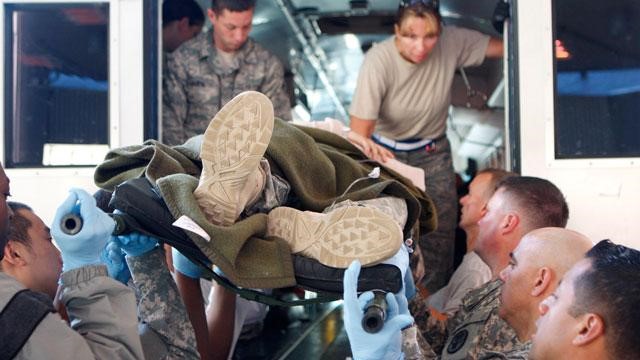During the war in Iraq and Afghanistan, patients were brought daily to Landstuhl Regional Medical Center, the military’s largest and only trauma center outside the United States. Army nurses served as a part of a huge healthcare team who took care of the ill and injured American and coalition military personnel, who came from the areas of conflict.
Generally, around 240-400 casualties each month received definitive medical care at the facility, and more than 90,000 injured/ill individuals from 56 countries were cared for over the course of the war.
 |
A US soldier wounded in Afghanistan is offloaded from the bus at Landstuhl Regional
Medical Center |
Patients were transported quickly and safely to Germany where they rarely stayed more than five days before leaving for the United States. When ICU patients arrived, they were greeted by the ICU staff wearing “bright yellow isolation gowns and protective gloves.” An Army reservist Major (then Captain) Sandy Peters related, “Basically, all they did was patch these patients up and send them out to us in Germany.... They [we]re covered in dirt and there [wa]s [some] bacteria that live[d] downrange ... called Acinetobacter. So, you [we]re completely gowned and gloved to protect yourself until they c[a]me up negative.”
The 18-bed ICU was dominated by trauma patients and those requiring “mechanical ventilation, invasive monitoring, or vasoactive infusions.... [They usually were] in varying stages of sepsis, acute respiratory distress, and multisystem organ failure.” Peters remembered, “We usually took care of just one patient, sometimes two. It was a lot of work. The patients would come, and you would put them in the room and connect them up to all the equipment. It was all hand charting. There w[ere] no computers. We usually didn’t have a clerk. You had to take off all your own orders.... You usually had to do everything yourself.” Generally, “[t]he ICU turnover was 48 hours – that mean[t] 12 new patients to be assessed, operated on, and otherwise cared for every two days.”
Medical-surgical units were just as busy. “The rooms [would] become crowded as members of multidisciplinary teams maneuvered around each other to triage and provide care. Nursing teams d[id] their best to welcome each patient to the units in the midst of assessments, medical history, and treatments.... The nurses continually attempt[ed] to balance completing their required care tasks and documentation while allowing patients to relax and experience the comforts of their short-term home.” Peters stated, “We would float into the short stay department when they got too many patients. The most we got was 26 patients in the short stay, which is a lot when you turn them over every three days. We would stabilize the patients and then fly them out.”
Often, patients had not realized the extent of their injuries until they reached Landstuhl. Nurses listened to horrendous stories of chaos of war, facilitated phone calls home to families, and helped in any way to alleviate their pain and suffering. Finally, once the patients stabilized, nurses did the voluminous paperwork to ensure they were well prepared to return to the United States.
LTC Dawn Garcia, head nurse of the combined intensive care unit, described why working at Landstuhl was so compelling, “once you’ve done this mission[,] ... it [was] very hard to walk away[.] It ha[d] so much purpose. No other job [could] compare with what we d[id.] We car[ed] for those who ensure[d] our freedom. They’re our heroes and we[, in turn, had] a big impact on their lives.